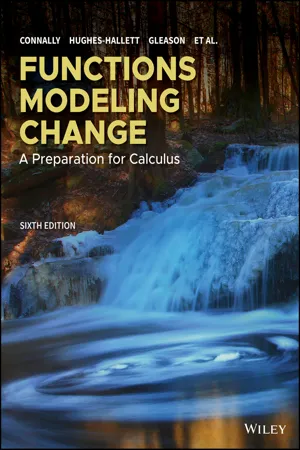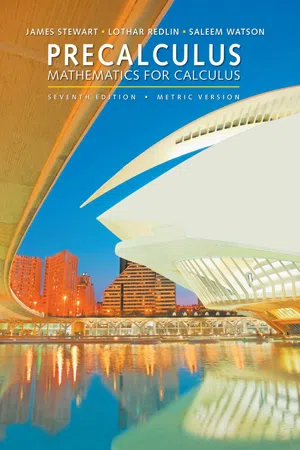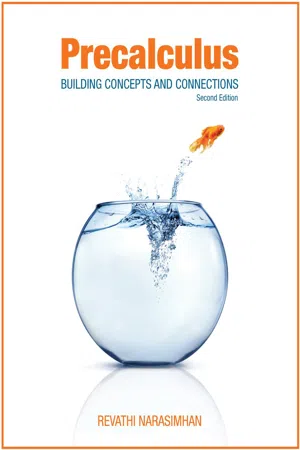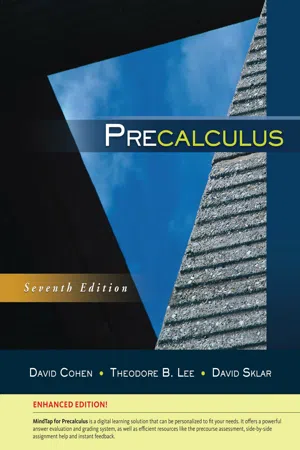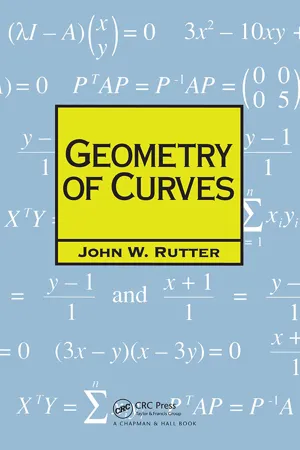Ellipse
An ellipse is a geometric shape that resembles a flattened circle, characterized by two foci and a major and minor axis. In mathematics, it is defined as the set of all points where the sum of the distances to the two foci is constant. The equation of an ellipse in the coordinate plane is commonly represented in standard form.
Related key terms
8 Key excerpts on "Ellipse"
- eBook - PDF
Functions Modeling Change
A Preparation for Calculus
- Eric Connally, Deborah Hughes-Hallett, Andrew M. Gleason(Authors)
- 2019(Publication Date)
- Wiley(Publisher)
Equivalence of the Algebraic and Geometric Definitions of the Ellipse In Section 14.3, an Ellipse was defined using rectangular coordinates as 2 2 + 2 2 = 1. In this section, we defined an Ellipse as the set of points in the plane for which the sum of the distances to two focal points is constant. We now show that these two definitions are equivalent in the case in Focus Focus Figure 14.37: Reflective property of an Ellipse 14.5 GEOMETRIC PROPERTIES OF CONIC SECTIONS 14-29 which the focal points are (±, 0) and the intercepts are (±, 0), with 0 < < . Some of the details are omitted; see Problem 44. Consider the set of points (, ) such that the sum of the distances to two focal points (±, 0) is constant. We have Sum of distances from (, ) to focal points = Sum of distances from (, 0) to focal points √ ( − ) 2 + 2 + √ ( + ) 2 + 2 = 2 √ ( − ) 2 + 2 = 2 − √ ( + ) 2 + 2 . Square both sides and simplify to obtain: −4 = 4 2 − 4 √ ( + ) 2 + 2 . Isolating the square root gives √ ( + ) 2 + 2 = 2 + . We square both sides and simplify again to obtain: 2 2 + 2 2 + 2 2 = 4 + 2 2 . Let = √ 2 − 2 . Then > 0. Since 2 = 2 − 2 , simplifying again gives − 2 2 + 2 2 = − 2 2 2 2 + 2 2 = 2 2 . Dividing through by 2 2 gives the equation for an Ellipse in rectangular coordinates: 2 2 + 2 2 = 1. Hyperbolas An Ellipse is the set of points for which the sum of the distances to two points is constant. If the difference in the distances to two points is constant, we have a hyperbola. The two points are again called the focal points, or foci. See Figure 14.38. A hyperbola is the set of points in the plane for which the difference of the distances to two points is constant. 8 Each of the two points is called a focus or focal point of the hyperbola. - No longer available |Learn more
- James Stewart, Lothar Redlin, Saleem Watson(Authors)
- 2016(Publication Date)
- Cengage Learning EMEA(Publisher)
Is it possible to angle the flashlight in such a way that the boundary of the lighted area is a parabola? Explain your answer. 11.2 EllipseS ■ Geometric Definition of an Ellipse ■ Equations and Graphs of Ellipses ■ Eccentricity of an Ellipse ■ Geometric Definition of an Ellipse An Ellipse is an oval curve that looks like an elongated circle. More precisely, we have the following definition. GEOMETRIC DEFINITION OF AN Ellipse An Ellipse is the set of all points in the plane the sum of whose distances from two fixed points F 1 and F 2 is a constant. (See Figure 1.) These two fixed points are the foci (plural of focus) of the Ellipse. F/ P F¤ FIGURE 1 Copyright 2017 Cengage Learning. All Rights Reserved. May not be copied, scanned, or duplicated, in whole or in part. Due to electronic rights, some third party content may be suppressed from the eBook and/or eChapter(s). Editorial review has deemed that any suppressed content does not materially affect the overall learning experience. Cengage Learning reserves the right to remove additional content at any time if subsequent rights restrictions require it. SECTION 11.2 ■ Ellipses 791 The geometric definition suggests a simple method for drawing an Ellipse. Place a sheet of paper on a drawing board, and insert thumbtacks at the two points that are to be the foci of the Ellipse. Attach the ends of a string to the tacks, as shown in Figure 2(a). With the point of a pencil, hold the string taut. Then carefully move the pencil around the foci, keeping the string taut at all times. The pencil will trace out an Ellipse, because the sum of the distances from the point of the pencil to the foci will always equal the length of the string, which is constant. - eBook - PDF
College Algebra
Building Concepts and Connections 2E
- Revathi Narasimhan(Author)
- 2019(Publication Date)
- XYZ Textbooks(Publisher)
The eccentricity of an Ellipse is defined as e = c _ a = √ — a 2 − b 2 _______ a , where a , b , and c are as defined in this section. Since 0 < c < a , the value of e lies between 0 and 1. In Ellipses that are long and thin, b is small compared to a , so the eccentricity is close to 1. In Ellipses that are nearly circular, b is almost as large as a , so the eccentricity is close to 0. What is the eccentricity of the Ellipse with equation x 2 __ 9 + y 2 __ 25 = 1? Does this Ellipse have a greater or lesser eccentricity than the Ellipse with equation x 2 __ 16 + y 2 __ 25 = 1? 4 3 6 . 3 6.3 The Hyperbola 521 Objectives ■ Define a hyperbola. ■ Find the foci, vertices, transverse axis, and asymptotes of a hyperbola. ■ Determine the equation of a hyperbola and write it in standard form. ■ Translate a hyperbola in the xy -plane. ■ Sketch a hyperbola. The last of the conic sections that we will discuss is the hyperbola. We first give its definition and derive its equation. The rest of this section will analyze various equations of hyperbolas, and conclude with an application to sculpture. Definition of a Hyperbola A hyperbola is the set of all points ( x , y ) in a plane such that the absolute value of the difference of the distances of ( x , y ) from two fixed points in the plane is equal to a fixed positive number d , where d is less than the distance between the fixed points. Each of the fixed points is called a focus of the hyperbola. Together, they are called the foci . A hyperbola consists of a pair of non-intersecting, open curves, each of which is called a branch of the hyperbola. The two points on the hyperbola that lie on the line passing through the foci are known as the vertices of the hyperbola. The transverse axis of a hyperbola is the line segment that has the vertices as its endpoints. See Figure l. The only hyperbolas discussed in this section are those whose transverse axes are either horizontal or vertical. - eBook - PDF
Precalculus
Building Concepts and Connections 2E
- Revathi Narasimhan(Author)
- 2016(Publication Date)
- XYZ Textbooks(Publisher)
Astronomy The orbit of the moon around Earth is an Ellipse, with Earth at one focus. If the major axis of the orbit is 477,736 miles and the minor axis is 477,078 miles, find the maximum and minimum distances from Earth to the moon. 64. Reflective Property An Ellipse has a reflective property. A sound wave that passes through one focus of an Ellipse and strikes some point on the Ellipse will be reflected through the other focus. This reflective property has been used in architecture to design whispering galleries, such as the one in the Capitol building in Washington, D.C. A weak whisper at one focus can be heard clearly at the other focus, but nowhere else in the room. The dome of the Capitol has an elliptical cross-section. If the length of the major axis is 400 feet and the highest point of the dome is 60 feet above the floor, where should two senators stand to hear each other whisper? Assume that the Ellipse is centered at the origin. 65. Physics A laser is located at one focus of an Ellipse. A sheet of metal, which is only a fraction of an inch wide and serves as a reflecting surface, lines the entire Ellipse and is located at the same height above the ground as the laser. A very narrow beam of light is emitted by the laser. When the beam strikes the metal, it is reflected toward the other focus of the Ellipse. If the foci are 20 feet apart and the shorter dimension of the Ellipse is 12 feet, how great a distance is traversed by the beam of light from the time it is emitted by the laser to the time it reaches the other focus? 66. Graphic Design A graphic artist draws a schematic of an elliptically-shaped logo for an IT firm. The shorter dimension of the logo is 10 inches. If the foci are 8 inches apart, what is the longer dimension of the logo? 60 ft. 400 ft. 762 Chapter 9 Conic Sections 67. Leisure One of the holes at a miniature golf course is in the shape of an Ellipse. The teeing-off point and the cup are located at the foci, which are 12 feet apart. - eBook - PDF
Intermediate Algebra
A Guided Approach
- Rosemary Karr, Marilyn Massey, R. Gustafson, , Rosemary Karr, Marilyn Massey, R. Gustafson(Authors)
- 2014(Publication Date)
- Cengage Learning EMEA(Publisher)
A third conic section is an oval-shaped curve called an Ellipse. Ellipses can be nearly round or they can be long and narrow. In this section, we will learn how to construct Ellipses and how to graph equations that represent them. Ellipses have optical and acoustical properties that are useful in architecture and engineering. For example, many arches are portions of an Ellipse, because the shape is pleasing to the eye. (See Figure 10-13(a).) The planets and many comets have elliptical orbits. (See Figure 10-13(b).) Gears are often cut into elliptical shapes to provide nonuni-form motion. (See Figure 10-13(c).) Section Objectives Vocabulary 2 3 Graph an Ellipse given an equation in standard form. Graph an Ellipse given an equation in general form. Solve an application involving an Ellipse. 1 The Ellipse Ellipse focus foci vertices major axis minor axis Solve each equation for the indicated variable 1 a 2 0 , b 2 0 2 . 1. y 2 b 2 5 1 for y 2. x 2 a 2 5 1 for x 10.2 Getting Ready Ellipses Arches Earth's orbit Earth Sun Gears (a) (b) (c) Figure 10-13 Copyright 2013 Cengage Learning. All Rights Reserved. May not be copied, scanned, or duplicated, in whole or in part. Due to electronic rights, some third party content may be suppressed from the eBook and/or eChapter(s). Editorial review has deemed that any suppressed content does not materially affect the overall learning experience. Cengage Learning reserves the right to remove additional content at any time if subsequent rights restrictions require it. 10.2 The Ellipse 703 Unless otherwise noted, all content on this page is © Cengage Learning. Graph an Ellipse given an equation in standard form. 1 THE Ellipse We can construct an Ellipse by placing two thumbtacks fairly close together, as in Fig-ure 10-15. We then tie each end of a piece of string to a thumbtack, catch the loop with the point of a pencil, and, while keeping the string taut, draw the Ellipse. - eBook - PDF
- David Cohen, Theodore Lee, David Sklar, , David Cohen, Theodore Lee, David Sklar(Authors)
- 2016(Publication Date)
- Cengage Learning EMEA(Publisher)
Write the answer in the form y mx b . (3, 4) Tangent ≈+3¥=57 y x Figure 13 Copyright 201 Cengage Learning. All Rights Reserved. May not be copied, scanned, or duplicated, in whole or in part. Due to electronic rights, some third party content may be suppressed from the eBook and/or eChapter(s). Editorial review has deemed that any suppressed content does not materially affect the overall learning experience. Cengage Learning reserves the right to remove additional content at any time if subsequent rights restrictions require it. We conclude this section by mentioning a few applications of the Ellipse. Some gears in machines are elliptical rather than circular. (In certain brands of racing bikes this is true of one of the gears in front.) As with the parabola, the reflection property of the Ellipse has applications in optics and acoustics. As indicated in Figure 14, a light ray or sound emitted from one focus of an Ellipse is always reflected through the other focus. This property is used in the design of “whispering galleries.” In these rooms (with elliptical cross sections) a person standing at focus F 2 can hear a whisper from focus F 1 while others closer to F 1 might hear nothing. Statuary Hall in the Capitol building in Washington, D.C., is a whispering gallery. This idea is used in a modern medical device known as the lithotripter, in which high-energy sound waves are used to break up kidney stones. The patient is positioned with the kidney stone at one focus in an elliptical water bath while sound waves are emitted from the other focus. An important application of the Ellipse occurs in astronomy: For a planet or comet revolving around the Sun, the orbit is an Ellipse with the Sun at one focus. (This fact was discovered empirically by Johannes Kepler in the early 1600s, and it was proved math-ematically by Isaac Newton in the 1680s.) In this context, the vertices of the Ellipse (that is, the endpoints of the major axis) have a special significance. - eBook - PDF
- Paul A. Calter, Michael A. Calter(Authors)
- 2011(Publication Date)
- Wiley(Publisher)
724 Chapter 22 ◆ Analytic Geometry 37. A curved mirror in the shape of an Ellipse will reflect all rays of light coming from one focus onto the other focus (Fig. 22–84). A certain spot heater is to be made with a heating element at A and the part to be heated at B, contained within an ellipsoid (a solid obtained by rotating an Ellipse about one axis). Find the width x of the chamber if its length is 25 cm and the distance from A to B is 15 cm. 38. The paths of the planets and certain comets are Ellipses, with the sun at one focal point. The path of Halley’s comet is an Ellipse with a major axis of 36.18 AU and a minor axis of 9.12 AU. An astronomical unit, AU, is the distance between the earth and the sun, about 92.6 million miles. What is the greatest distance that Halley’s comet gets from the sun? 39. An elliptical culvert (Fig. 22–85) is filled with water to a depth of 1.0 ft. Find the width w of the stream. x B A FIGURE 22–84 Focusing property of the Ellipse. 4.0 ft 1.0 ft w 8.0 ft FIGURE 22–85 V F 2 P E F 1 C 1 C 2 L 2 S 2 L 1 S 1 FIGURE 22–86 a a b b o (a) p n m a a b b o (c) a p n m b (b) FIGURE 22–87 40. Project: Another Definition of the Ellipse. We have defined an Ellipse as the set of all points in a plane such that the sum of the distances from two fixed points is constant. We have also defined it as the curve obtained by intersecting a plane with a cone. Referring to Fig. 22–86, show that these two definitions are consistent. (a) Let E be the curve in which a plane intersects a cone, and P be any point on that curve. (b) Insert a sphere into the cone so that it touches the cone along circle and is tangent to the cutting plane at point Similarly insert sphere touching the cone along circle and the plane at point (c) Show that is a constant, regardless of where on E the point P is chosen. (Hint: Draw element VP and extend it to where it intersects at Then use the fact that two tangents drawn to a sphere from a common point are equal.) 41. - eBook - PDF
- J.W. Rutter(Author)
- 2018(Publication Date)
- Chapman and Hall/CRC(Publisher)
1.4 The Ellipse in canonical position In many situations the circle (see §2.1) can be regarded as a special case of an Ellipse. However we consider in this section only Ellipses which are not circles, that is we assume that a > b (see below). The Ellipse in canonical position is shown in Figure 1.5. 1.4-1 Algebraic equation The algebraic equation of the Ellipse in canonical position is -2 + y ¥ = l (a>b>0). This curve meets the coordinate axes at (±a,0) and (0, ±b). 1.4-2 Parametric equation The standard parametric equation of the Ellipse in canonical position is r = (x,y) = (a cos, b sin (p) (0 < ip < 2-K) (a > b > 0). In this caseb > 0). In this equation the centre of the Ellipse (see below) is the pole, and the positive x-axis is the initial half-line. The polar equation with a focus as the pole is given in §1.8. 1.4-4 Terminology The centre of this Ellipse is at the origin: in the case of general position, the centre of the Ellipse is its centre of symmetry. There are two foci at (±ae,0), where ! ò 2 ^ V 1 ^ ( 0 < e < ! ) is the eccentricity of the Ellipse. Here a and b are selected by b < a. The singular of foci is focus. Notice that the distance of the foci from the centre is ae — ya 2 - 6 2 . The major axis is the chord or the line through the foci, and the minor axis is the chord or the line through the centre perpendicular to the major axis.
